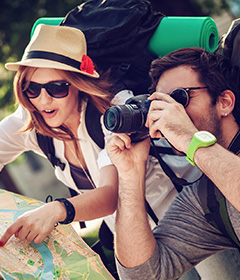The landscape of corporate travel is evolving rapidly, with a growing trend that seamlessly blends business and leisure into a single experience. This phenomenon, known as “bleisure” travel, is reshaping how professionals approach work-related trips. No longer content with rushing from airport to meeting room and back, today’s business travellers are increasingly extending their stays to explore destinations, unwind, and create memorable experiences alongside their work commitments.
As companies recognise the potential benefits of this trend—including improved employee satisfaction and productivity—many are adapting their policies to accommodate and even encourage bleisure travel. This shift represents a significant change in corporate culture, acknowledging the importance of work-life balance and the value of personal experiences in professional development.
Evolution of bleisure travel in corporate culture
The concept of bleisure travel has been gaining momentum for several years, but recent global events have accelerated its adoption. With remote work becoming more prevalent, the lines between professional and personal time have blurred, leading to a reevaluation of how business travel can be structured.
Companies are increasingly recognising that allowing employees to extend their business trips for leisure purposes can lead to numerous benefits. These include increased job satisfaction, better work-life balance, and even improved performance on business objectives. As a result, many organisations are updating their travel policies to explicitly accommodate bleisure options.
One of the key drivers behind this evolution is the changing demographics of the workforce. Millennials and Gen Z professionals, who now make up a significant portion of business travellers, place a high value on experiences and work-life integration. They are more likely to seek out opportunities to explore new destinations and cultures, even within the context of a work trip.
Bleisure travel is not just a trend, but a reflection of changing attitudes towards work and life integration in the modern corporate world.
This shift in corporate culture has also been influenced by the recognition that well-rested and fulfilled employees are more likely to perform at their best. By allowing for leisure time during business trips, companies are investing in their employees’ well-being and, by extension, their productivity and loyalty.
Integrating leisure into business trip itineraries
The art of integrating leisure activities into business travel requires thoughtful planning and flexibility. Savvy travellers and forward-thinking companies are finding innovative ways to make the most of work trips by incorporating personal time and experiences. Here are some strategies for successfully blending business and leisure:
Pre-trip extension: maximising weekends for personal exploration
One popular approach to bleisure travel is arriving at the destination a few days early, particularly over a weekend. This allows travellers to acclimate to the new time zone, explore the local area, and start their business engagements feeling refreshed and familiar with their surroundings. For example, a professional attending a conference in Barcelona might arrive on Friday evening, spend the weekend exploring the city’s famous architecture and beaches, and then begin work commitments on Monday feeling energised and culturally immersed.
Post-conference stays: leveraging event locations for tourism
Another common bleisure strategy involves extending the stay after the primary business purpose has concluded. This approach allows travellers to fully focus on work during the event, knowing they have dedicated leisure time afterwards. For instance, after a week-long trade show in Tokyo, an employee might spend an additional three days exploring Japanese culture, visiting historic temples, or even taking a short trip to nearby Mount Fuji.
Workation strategies: balancing productivity and local experiences
The rise of remote work has given birth to the concept of “workations,” where professionals combine work and vacation by choosing a destination that allows them to fulfil their job responsibilities while also enjoying new surroundings. This might involve booking a stay at a resort with robust Wi-Fi and workspace options, allowing for a productive workday followed by evening exploration or weekend adventures.
Bleisure-friendly destinations: from singapore’s marina bay sands to dubai’s DIFC
Certain destinations have positioned themselves as particularly conducive to bleisure travel. These locations often feature a mix of business infrastructure and leisure attractions. Singapore’s Marina Bay Sands, for example, offers world-class conference facilities alongside iconic rooftop infinity pools and proximity to cultural attractions. Similarly, Dubai’s International Financial Centre (DIFC) combines cutting-edge business amenities with easy access to luxury shopping, desert safaris, and architectural marvels like the Burj Khalifa.
Technology enabling seamless bleisure experiences
Advancements in technology have played a crucial role in facilitating the rise of bleisure travel. Various tools and platforms are making it easier for travellers to manage the dual aspects of their trips efficiently. Here’s how technology is shaping the bleisure landscape:
Mobile apps for dual-purpose travel management
Innovative mobile applications are emerging to help travellers seamlessly manage both the business and leisure components of their trips. These apps often integrate features such as itinerary management, expense tracking, and local recommendations. For example, some apps allow users to easily switch between business and personal modes, ensuring accurate expense allocation and providing tailored suggestions for free time activities.
Virtual meeting platforms supporting remote work during extended stays
The widespread adoption of virtual meeting platforms has made it possible for professionals to extend their trips without sacrificing productivity. High-quality video conferencing tools enable travellers to participate in important meetings or presentations from almost anywhere, allowing for greater flexibility in combining work and leisure time.
Ai-powered itinerary planners for optimised schedules
Artificial intelligence is revolutionising travel planning, with sophisticated algorithms capable of creating optimised itineraries that balance work commitments with leisure activities. These AI planners can take into account factors such as meeting schedules, personal preferences, and local events to suggest the most efficient and enjoyable bleisure experience.
Bleisure-specific features in corporate booking tools
Corporate travel booking platforms are evolving to include features specifically designed for bleisure travellers. These might include options to extend hotel stays at corporate rates, add leisure activities to business itineraries, or easily split expenses between personal and business accounts. Such features streamline the process of planning and managing bleisure trips, making it more accessible and appealing to a wider range of corporate travellers.
Technology is not just facilitating bleisure travel; it’s redefining the very nature of how we combine work and play in our increasingly connected world.
Corporate policies adapting to bleisure trends
As bleisure travel becomes more prevalent, companies are revisiting and revising their corporate travel policies to accommodate this new reality. This adaptation involves careful consideration of various factors to ensure that both the company’s interests and the employee’s well-being are addressed. Here are key areas where corporate policies are evolving:
Duty of care considerations for extended business trips
Companies have a legal and ethical obligation to ensure the safety and well-being of their employees during business travel. With bleisure trips extending the duration of stays, organisations are expanding their duty of care policies to cover the entire trip, not just the business portion. This might include providing extended travel insurance coverage, offering 24/7 support services, and implementing robust communication protocols for emergencies that may occur during the leisure part of the trip.
Expense management protocols for combined Business-Leisure travel
One of the most complex aspects of bleisure travel from a policy perspective is expense management. Companies are developing clear guidelines on what expenses are covered during the business portion of the trip and what falls under personal responsibility. Some organisations are implementing sophisticated expense tracking systems that allow employees to easily categorise expenses as business or personal, ensuring transparency and compliance with company policies.
HR policies on Work-Life integration during business travel
Human Resources departments are playing a crucial role in shaping bleisure-friendly policies. This includes addressing questions about work expectations during extended stays, time off in lieu for weekend travel, and how bleisure opportunities should be distributed among employees. Progressive companies are viewing bleisure as a potential employee benefit, recognising its value in attracting and retaining talent in a competitive job market.
To effectively implement these policy changes, companies are focusing on clear communication and employee education. This ensures that all staff members understand the opportunities and responsibilities associated with bleisure travel, promoting a culture of trust and mutual benefit.
Economic impact of bleisure on business travel industry
The rise of bleisure travel is having a significant economic impact on various sectors of the travel industry. As travellers extend their stays and seek more diverse experiences, businesses are adapting their offerings to cater to this growing market segment. Here’s how different sectors are capitalising on the bleisure trend:
Extended stay hotels capitalising on bleisure market
Hotels, particularly those in the extended stay category, are experiencing a boom thanks to bleisure travel. These properties are ideally suited for longer stays, offering amenities like kitchenettes, workspaces, and fitness facilities that cater to both business and leisure needs. Many hotels are now marketing specifically to bleisure travellers, offering packages that combine business-friendly services with leisure experiences.
Airlines’ flexible fare structures for multi-purpose trips
Airlines are adapting their fare structures and loyalty programs to accommodate the bleisure trend. This includes offering more flexible booking options, such as open-jaw tickets that allow travellers to fly into one city and out of another. Some airlines are also partnering with hotels and tour operators to offer comprehensive bleisure packages, making it easier for travellers to plan and book extended trips.
Tourism boards’ strategies to attract bleisure travellers
Recognising the potential of bleisure travel to boost local economies, many tourism boards are developing targeted marketing campaigns and initiatives to attract this lucrative segment. This might involve promoting business-friendly infrastructure alongside leisure attractions, or creating specialised guides and resources for bleisure travellers. Some destinations are even offering incentives for business travellers to extend their stays, such as discounted attraction passes or special rates on accommodations.
The economic benefits of bleisure travel extend beyond just increased spending. By encouraging longer stays and more diverse activities, it can help distribute tourism revenue more evenly across different sectors of the local economy, from restaurants and retail to cultural attractions and outdoor activities.
Measuring ROI and employee satisfaction in bleisure programs
As companies invest in bleisure-friendly policies and programs, measuring their return on investment (ROI) and impact on employee satisfaction becomes crucial. This assessment helps organisations refine their approaches and justify continued support for bleisure initiatives. Here are some key metrics and methods for evaluating the success of bleisure programs:
Employee Satisfaction Surveys: Regular surveys can gauge how bleisure opportunities affect job satisfaction, work-life balance, and overall employee well-being. Questions might address the perceived value of bleisure options, their impact on job performance, and whether they influence decisions to stay with the company.
Productivity Metrics: Companies can track productivity metrics before and after bleisure trips to assess any changes. This might include measures like sales performance, project completion rates, or client satisfaction scores.
Cost-Benefit Analysis: A thorough cost-benefit analysis can help quantify the financial impact of bleisure programs. This might consider factors such as potential savings on separate vacation travel, increased willingness to undertake business trips, and any reductions in employee turnover attributed to bleisure opportunities.
Health and Well-being Indicators: Tracking metrics related to employee health and well-being, such as stress levels, sick days taken, or engagement scores, can provide insights into the broader impact of bleisure travel on workforce wellness.
Long-term Career Development: Assessing how bleisure experiences contribute to employees’ professional growth and cultural competence can highlight less tangible but equally valuable benefits of these programs.
By systematically evaluating these factors, companies can gain a comprehensive understanding of how bleisure programs contribute to both the bottom line and the overall health of their organisation. This data-driven approach allows for continuous improvement and adaptation of bleisure policies to maximise their benefits for both employees and the company.
As the business world continues to evolve, bleisure travel stands out as a trend that aligns professional needs with personal aspirations. By embracing this approach, companies can foster a more engaged, satisfied, and productive workforce while simultaneously adapting to the changing expectations of modern professionals. The future of business travel looks set to be more flexible, enriching, and balanced than ever before.


